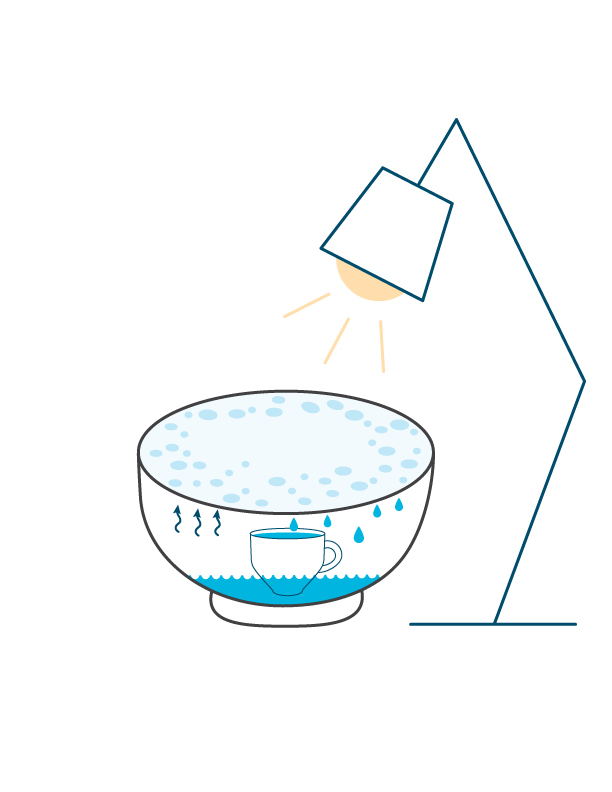Classroom water cycle experiment
Predict, observe and learn with this mini water cycle experiment.

Overview
Let’s experiment. Create a functional water cycle. Make predictions and observations about evaporation, condensation, precipitation and runoff to see how the water cycle works first hand.
Instructions
What you'll need
- “Water cycle” image
- “Water cycle experiment” worksheet
- "How do dams work?" video
- Projector and screen to show video
- Large glass bowl
- Mug
- Plastic wrap
- String or large rubber band
- Warm water
- Small stone or marble
- Sun or lamp
- Watch the "How do dams work?" video.
- Try this activity in the morning so there’s time to make observations about the experiment at the end of the day.
- Play “I spy” before the demo to engage our powers of observation.
- Now set up the water cycle demo:
- Place the mug in the centre of the bowl.
- Pour warm water into the bowl until it’s about half or two-thirds of the way up the mug.
- Loosely cover the bowl with plastic wrap and seal it with string or a rubber band.
- Place a stone or marble on the plastic wrap (making sure the plastic wrap doesn’t touch the mug).
- Place the bowl by a sunny window or next to a lamp.

- Have students predict what will happen using the “Water cycle experiment” worksheet. Share predictions in partners and discuss as a class.
- Check back in a couple hours and again at the end of the day, recording observations on the worksheet each time.
- Discuss in partners how this experiment is similar to the water cycle.
- Review the “Water cycle” image.
- Have students fill in the blanks on page 2 of the worksheet.
- Do students have suggestions for modifying the experiment?

Modify or extend this activity
Extensions
- Have students design their own water cycle experiment to demonstrate one or more stages in the water cycle (evaporation, condensation, precipitation or runoff).
- Instead of doing a class demonstration, show students the materials and ask them to brainstorm ways to create and experiment that demonstrates the water cycle. Share ideas and discuss.
- Watch a fun video and lead a quick activity about the “Power of falling water”.
Curriculum Fit
Grade 2 Science
Content
- Water sources including local watersheds
- Water cycle
Curricular competencies
Questioning and predicting
- Demonstrate curiosity and a sense of wonder about the world
- Observe objects and events in familiar contexts
- Ask questions about familiar objects and events
- Make simple predictions about familiar objects and events
Planning and conducting
- Make and record observations
Processing and analyzing data and information
- Sort and classify data and information using drawings, pictographs and provided tables
- Compare observations with predictions through discussion
Evaluating
- Compare observations with those of others
Communicating
- Communicate observations and ideas using oral or written language, drawing or role-play
Assessments
- Assess student worksheet for ability to make and record observations.
- Assess worksheet for an understanding of the water cycle.
- Assess ability to share and discuss predictions and observations during partner and class discussions.
Teaching Notes
Water cycle
Earth has a limited supply of water that is cycled over and over again. The water cycle is an important process on earth because living things, including animals and humans, need water to grow and survive. Water is used for drinking, growing food, providing habitat, generating electricity and more. The sun has been driving the water cycle on Earth for billions of years. The four main stages of the water cycle are evaporation, condensation, precipitation and runoff.
- Sun: The water cycle is driven by the energy from the sun warming the earth. The sun or a lamp can be used in the experiment to warm the water and represent the sun.
- Evaporation: The warmth of the sun causes water from lakes, rivers and oceans to evaporate and turn from a liquid to a gas. The water vapour (gas) rises up into the air. The water from the bowl evaporates and rises up to the plastic wrap.
- Condensation: The water vapour cools as it rises and turns back into water droplets, forming a cloud. The condensation gathers on the inside of the plastic wrap to represent the condensation forming clouds.
- Precipitation: Water droplets in a cloud eventually become too big and heavy and fall from the clouds in the sky. It can fall as rain, snow, hail, etc. The water droplets gather on the plastic wrap where the stone is placed, falling into the mug.
- Runoff: After the precipitation falls, it flows down towards the ocean and collects in rivers, lakes and streams. Some of it collects underground as well. The water in the mug represents the runoff in the water cycle.
- And then the cycle begins again.








